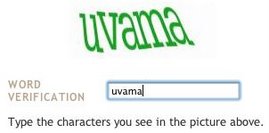Complete either the telephone quiz or the alternative assignment. If you want to practice for the telephone quiz, use Wimba.
Subscribe to:
Post Comments (Atom)
This blog is for Athabasca University students in English 140:Grammar.
Complete either the telephone quiz or the alternative assignment. If you want to practice for the telephone quiz, use Wimba.

Check out the Student Awards web site for all the details.

For a humourous look at grammar and some of the stickier grammatical situations, check out Grammar Girl. There is a site called Quick and Dirty Tips, and there is also a series of podcasts available. A book on the same topic has just been published. For those of you who are on Facebook, you might like to become a fan of Grammar Girl.
Before you access WIMBA for the first time, please send me an e-mail (veronica@athabascau.ca) indicating that you want to use this resource.
1. Access WIMBA
2. The link takes you to the WIMBA resource page—click on WIMBA.
3. Enter your e-mail address and your password (English)—then you will see the My Wimba page.
4. Click on English 140—Introduction
5. Click on Introductory Message and then the forward arrow on the toolbar. You should then hear the message.
6. To reply, click on the Reply button and the forward button, and begin to record your message.
7. For more information about using WIMBA, please return to the WIMBA resource page and click on User Guide, Sound Tips, or Technical Help.
8 comments:
How do you use Much/Many/More in a sentence?
Use "much" before a noncount noun and "many" before a count noun: e.g. There is much information available on the Internet, or There are many news items available on the Internet. You can use "more" with either of these words: e.g. There is much more information available on the Internet now than 5 years ago, or There are many more news items available ...
A count noun is one you can put numbers in front of--one apple, two apples, etc.
A noncount is one you can't count--rice. The only way to count it is to put some measure in front of the word--grains/cups/bags of rice.
Also what do you do with the word "very"? "I love you so very much" or "I love you so very much more..."
The word "very" is an adverb; it's also an intensifier (it intensifies the word following it). You can use it in positive sentences such as your examples. In these sentences, however, "much" is not a quantifier before a noun. With "so very much more ..." you have the start of a comparative--"so very much more than something".
Workbook, Pg.43,Practice 3, Q. 11 :
"The furniture in those rooms (is/are) comfortable."
I chose "are" but the book says "is". I figured that "furniture" is a noncount word and that in this context it is plural or referring to many pieces of furniture; because of being more than one, I figured "are" would be used.
Even though noncount nouns usually contain many components--when we say "furniture" we do think of more than one piece of furniture--it is treated as a singular. For that reason use a singular verb and refer to it with a singular pronoun.
I came up with an example that falls into the same situation, and I am still confused.
"The sheep on the hills (is/are) cute." I figure sheep is another noncount but being used in a plural sense so "are" would be chosen but by the book's reasoning it would seem that "is" would be the answer. What's going on here?
The problem here is that "sheep" is not a noncount noun--it's simply an irregular plural. The plural and the singular forms are the same. Think about it--most of us do try counting sheep at one time or another!
Post a Comment